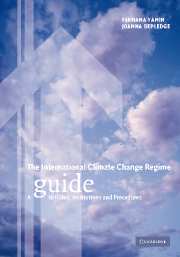Book contents
- Frontmatter
- Contents
- List of figures
- List of tables
- List of boxes
- Foreword by Joke Waller Hunter, Executive Secretary, FCCC
- Preface and acknowledgements
- List of abbreviations
- 1 Introduction
- 2 Overview
- 3 Regime participants
- 4 Objective and principles
- 5 Mitigation commitments
- 6 Flexibility mechanisms
- 7 Research, systematic observation, education, training and public awareness
- 8 Adaptation
- 9 Impacts of response measures
- 10 Finance, technology and capacity-building
- 11 Reporting and review
- 12 Compliance
- 13 Institutions
- 14 The negotiation process
- 15 Scientific and technical input
- 16 Administering the regime
- 17 Linkages
- 18 Evolution of the regime
- 19 Conclusion: taking stock and moving forward
- Appendix I List of Parties, their groups and key statistics
- Appendix II Annex I Party fact sheets: emissions, targets and projections for Annex I Parties and groupings
- Appendix III Table of Articles, issues and COP Decisions
- Bibliography
- Index
6 - Flexibility mechanisms
Published online by Cambridge University Press: 16 July 2009
- Frontmatter
- Contents
- List of figures
- List of tables
- List of boxes
- Foreword by Joke Waller Hunter, Executive Secretary, FCCC
- Preface and acknowledgements
- List of abbreviations
- 1 Introduction
- 2 Overview
- 3 Regime participants
- 4 Objective and principles
- 5 Mitigation commitments
- 6 Flexibility mechanisms
- 7 Research, systematic observation, education, training and public awareness
- 8 Adaptation
- 9 Impacts of response measures
- 10 Finance, technology and capacity-building
- 11 Reporting and review
- 12 Compliance
- 13 Institutions
- 14 The negotiation process
- 15 Scientific and technical input
- 16 Administering the regime
- 17 Linkages
- 18 Evolution of the regime
- 19 Conclusion: taking stock and moving forward
- Appendix I List of Parties, their groups and key statistics
- Appendix II Annex I Party fact sheets: emissions, targets and projections for Annex I Parties and groupings
- Appendix III Table of Articles, issues and COP Decisions
- Bibliography
- Index
Summary
Introduction
The costs of climate change and adaptation to its impacts are unknown. After sinks, the biggest factor influencing Annex I Parties' compliance cost is the geographic availability of mitigation measures. As location of abatement measures is climatically irrelevant, global cost-effectiveness prescribes that the cheapest mitigation options should be undertaken wherever they are located. The principle that groups of Parties with differential compliance costs could cooperate in jointly implementing mitigation measures beyond their territories was accepted in the Convention. But widely divergent interpretations of what this principle should mean in practice led Parties to launch the pilot phase of activities implemented jointly.
The Protocol provided clarity by including three innovative mechanisms allowing Annex I Parties to achieve their Article 3.1 mitigation commitments by undertaking, financing or purchasing emissions reductions generated overseas. These mechanisms are joint implementation (JI), the Clean Development Mechanism (CDM) and emissions trading (ET) pursuant to Articles 6, 12 and 17 of the Protocol respectively. For those unfamiliar with the Kyoto mechanisms, table 6.1 provides an overview of their key features.
Although inclusion of flexibility mechanisms enabled countries to commit to more environmentally stringent targets at Kyoto than might otherwise have been the case, their application to the international context on so large a scale was without precedent and raised novel moral, equity and environmental considerations explained in box 6.1. Most of these could not be resolved at Kyoto.
- Type
- Chapter
- Information
- The International Climate Change RegimeA Guide to Rules, Institutions and Procedures, pp. 136 - 196Publisher: Cambridge University PressPrint publication year: 2004



